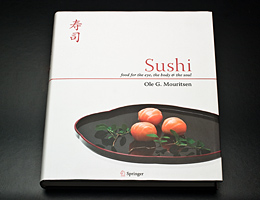-

- Mouritsen, Ole G.: Sushi: Food for the Eye, the Body & the Soul
Springer; New York
1st English ed., 2009, 360pp, 429 illus., 397 in color., Hardcover
ISBN: 978-1-4419-0617-5
At the over-matured sushi
the Master
is full of regret
- Matsuo Bashō (1644-1694)
3. “Something from the sea & something from the mountains”
The oceans of the world are filled with a vast abundance of fish and shellfish which are very suitable for the preparation of sushi. Some can be eaten raw, while others must first be cooked, marinated, or fermented. There is a wealth of colours – white fish, red fish, shiny fish – and a variety of patterns and textures. As a bonus, fish and shellfish are healthy foodstuffs, low in calories, and rich in proteins and superunsaturated fats.
Seaweed are algae that are found in all climate zones all around the world. The smallest algae are unicellular and some are related to bacteria and fungi. The largest are multicellular seaweeds that are several meters long. Most algae are able to photosynthesize, but they are not real plants. Seaweed is a neglected nutritional source in the Western world, but is fundamental in Japanese cuisine, especially in sushi.
Soybeans are full of proteins and unsaturated fats, which make them an important nutritional source for both humans and animals. The beans can be eaten either as they are (edamame) or processed into tofu, shōyu (soy sauce), miso, or a whole series of other items. Soy sauce is the most common flavouring agent in the Japanese cuisine. Soy products are also an essential part of every Japanese meal, especially sushi.
Rice is probably the single most important source of human nutrition. For more than half of the world’s people, rice is their staple. There are several thousand varieties of rice, which are roughly divided into three groups: those with short, long, and medium length grains. In Japanese cuisine, and especially in the preparation of sushi, only short-grained rice is used. Rice wine (sake) and rice vinegar (su) are other important products made from rice.
Spices play a much less prominent role in Japanese cuisine than in its European counterparts and in those of other parts of the Orient. Spices are not mixed with Japanese food, but are most commonly used as a condiment, for example, as a topping, a sauce, or simply as a complementary side dish. They are generally derived from aromatic plants like wasabi, shiso, and sesame seeds (goma) or from a variety of vegetables which are pickled in brine.